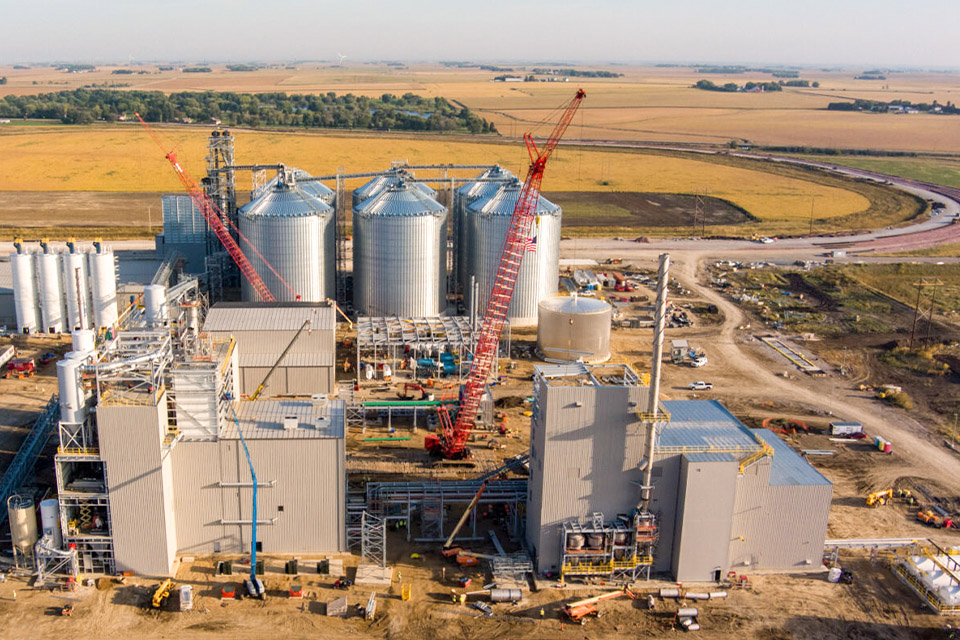
First-in-class soybean crushing facility being built in Alta, Iowa. (Photo: Platinum Crush)
Showcasing ISA trial results and touring Platinum Crush
February 22, 2024 | Kriss Nelson
From agronomics including nutrients, seeding-rate trials, conservation and cost-share opportunities to processing, discussions during the Iowa Soybean Association’s (ISA) Innovation to Profit meeting in Storm Lake took the soybean full-cycle.
Ben Wells, an ISA farmer-member from Pocahontas County, shared his experience working with ISA’s Research Center for Farming Innovation (RCFI).
Wells says he has been working with RCFI on trials for the past five years, including foliar micronutrient testing, participating in the northwest Iowa cover crop tour, and the Iowa Nitrogen Initiative.
“Participating in trials is made easy,” says Wells. “RCFI does all the legwork. They set up the trials, making it easy for us to analyze our data. Plan ahead for your trials. Now is a great time to work with the ISA research agronomists.”
Besides the knowledge gained about his farm, Wells especially appreciates the unbiased, data-driven results.
“The Iowa Soybean Association is an independent company; they never try to sell me anything, and the data is accurate,” says Well. “It’s more than data just for my farm; it is data combined with other farmers in the area and across the state.”
Richard Marshall, an ISA farmer-member from Alta, keeps himself educated by reading the Iowa Soybean Review and enjoyed putting faces to some of the people at ISA.
Already aware of trial opportunities, Marshall says he mainly learned about ISA's alliances with the Soil Water Outcome Fund and the Iowa Agriculture Water Alliance.
It was the opportunity to bring more exposure to son, Kevin Marshall, who is the reason behind attending the Innovation to Profit meeting.
“Kevin is coming back to the farm, working for me, and will begin farming,” says Richard. “He has been working off the farm, and I am trying to expose him to as much information as possible.”
While soaking up information and scanning QR codes during presentations, Kevin says he appreciated the chance to become more acquainted with ISA and may consider taking part in strip trials someday.
“I am learning these new technologies to my advantage,” says Kevin.
Long-term cover crop trials
ISA Analyst Anthony Martin shared the history and some of the early results found during the long-term cover crop study.
“This is a one-of-a-kind project that has a lot of eyes on it, so we want to keep this going on as many sites as possible,” says Martin.
These trial sites consist of cover crops seeded in the same strips each fall, with uncovered check strips for comparison.
There are currently 15 trial locations around the state, with the longest-running trials entering their eighth year.
When comparing yield differences, Martin says that changes have been small and slow to show.
From 108 site years analyzed, yield differences for both corn and soybean hovered near even when looking at years in cover, with soybeans seeing a slight increase in yield during the later years.
Average responses in corn ranged from approximately -1.25 to 1.25 bushels to the acre and soybeans between approximately -1.5 to 1.5 bushels to the acre.
When looking across years in cover, yield variability is minimized with continued use of a cover crop beyond three to four years, indicating improved yield stability.
“The important takeaway is that while we don’t see a significant yield increase, we don’t see significant losses either,” says Martin.
ISA is leading a project called the Improved Cropping System. With support from Iowa State University, the Iowa Corn Promotion Board, and funding from USDA-NRCS, the long-term cover crop trials will continue.
“We hope to answer more questions and examine the benefits of a cover crop blend instead of a single species,” says Martin.
Additional research will include soil moisture sensing as a proxy for workability, weed counts to determine suppression from biomass, and additional soil health sampling.
Platinum Crush
The day ended with attendees getting an up-close look at the new soybean processing facility being constructed near Alta.
Platinum Crush is nearing completion, with a targeted crushing day to begin May 1.
At the time of the tour, the facility was storing a million bushels of soybeans brought in to help test equipment. So far, that portion of the facility is proving to be in working condition and there are plans to take soybeans by March.
Scott Frerichs, vice president of manufacturing and engineering for Platinum Crush, says the dump pits are set up to receive 30,000 bushels per hour, which equates to 60 trucks an hour.
“We are moving trucks in and out in eight minutes from when you hit the gate and back. We are focusing on serving the farmer,” says Frerichs.
The plant is being built around soybean oil demand for renewable diesel. Product will most likely be shipped to renewable diesel plants in Louisiana, Texas and the West Coast.
In addition to the soybean oil, the facility is expected to produce the amount to fill 26 rail cars daily.
Jay Nelson, director of trading and risk management for Platinum Crush, says the plant will crush 38.5 million bushels of soybeans a year.
“Whether I am buying soybeans from the farmer or the cooperative, I will need them,” says Nelson.
With the addition of Platinum Crush, making it the second new soybean crushing plant to be built in Iowa, and the potential of 25 other plants being built new or expanding, Nelson hopes Iowans can get away from exporting whole soybeans.
“Last year, 41% of soybeans in northwest Iowa were exported in trains. We are going to stop that from happening,” says Nelson. “When that happens, you are no longer pricing beans against an export value, usually a lower price, and competing against South American production. This plant is going to change your basis values dramatically.”
Back